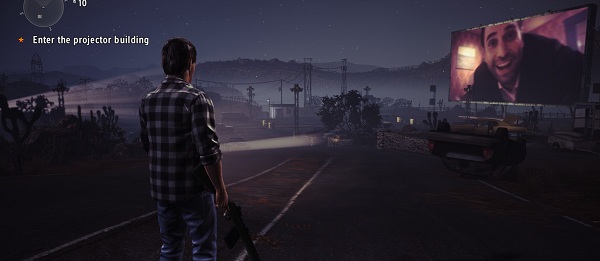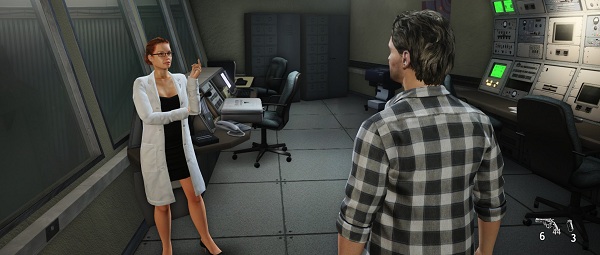Wot I Think: Alan Wake’s American Nightmare
Arizona Dreamin'
It took Alan Wake ages to find his way to PC but his second adventure arrived almost immediately after its XBLA release. At this rate, the planned full-blown sequel will arrive in 2007, long before it surfaces on the Microbox 7.20. But if American Nightmare isn’t a sequel, what is it? An arcade, action-orientated spinoff? An experimental short story? A fever dream? Expect spoilers for the first game as I tell you wot I think.
Remember how Alan Wake was about a man in a haunted forest? Alan Wake’s American Nightmare is a game in which playing a Kasabian CD in a certain place causes a satellite to fall out of the sky and destroy an oil well.
When I read Alec’s judgement of Alan’s vacation in Bright Falls I realised that I agreed with everything he said while also thinking that I’d enjoyed the game a lot more than he seemed to. Maybe my tolerance for repetitive action sequences is higher, or maybe it’s a game that becomes less of a chore in memory. Although I’m loathe to defend the eventual damp squib of a plot, which never seemed quite outlandish enough for my liking, despite alternate dimensions, rescripted realities and evil doppelgangers, I’ve found myself doing exactly that on numerous occasions.
But it’s supposed to be a bit daft, I find myself saying, it’s a cocktail of horror story conventions with a self-aware sheen. And of course he’s supposed to be a bit of a dick, I’ll wave my arms as I exclaim, he’s a trumped up success story who knows deep down that those manuscript pages, just like the works that made him famous, are a bit crap.
The manuscript pages are still a bit crap and Alan still bangs on about being a writer but this time around he accepts that he’s little more than a flashlight and a gun. It’s clearer now that the last thing Alan needs to be judged on is his writing. Although there’s some wibbly nonsense about rewriting events to change their outcome, like everything else Alan does, performing such metaphysical actions boils down to burning shadows from monster men with a flashlight and then shooting them with a gun. Maybe you’ll have to press a button afterwards or put a battery in a battery container. What you definitely won’t have to do is write anything.
Alan Wake isn’t a writer and Alan Wake isn’t a game about a writer. It’s a game about a man with a gun and flashlight (which is also, functionally, a gun) who tells everyone that he meets that he’s a writer. If CODBLOPS The Second has a main character who has published military memoirs to pay for his extravagant lifestyle, it won’t suddenly be a game about a writer; it’ll be a game about a man with some guns shooting other men. Alan Wake’s American Nightmare is a game about a man with some guns shooting other men.
That out of the way, here’s how the shooting works: exactly the same as in the first game. Enemies, corrupted by darkness, must have a flashlight turned on them, the beam intensified by a squeeze of the left trigger, and eventually a flash of silver light heralds the destruction of the dark and the right trigger can be squeezed instead of the left. BANG. Alan has more choice of weaponry for that right trigger this time around, from a nail gun to a combat shotgun, as well as his supply of flares and flashbangs.
Even though the combat works in identical fashion in terms of control, there’s a greater variety of enemies this time around and you’re more likely to be swarmed by them so things are a little more interesting. If you played the first game you’ll know that ‘a greater variety of enemies’ means more than two so don’t expect a wide-ranging menagerie of Taken. There are big ones, even bigger ones, little ones that split into two when the light hits them, scrawny ones that transform into flocks of birds as a form of teleportation and a few variations of the standard assailant. Oh, and spiders, which seem quite different and threatening at first but then they pretty much die as soon as Alan looks at them. Rubbish spiders.
All of this torching and gunning takes place in three locations on the outskirts of the fictional town of Night Springs, Arizona. It’s not just fictional because it was made up for the game, it’s a fictional place IN the game. Alan is trapped in an episode of the Twilight Zone parody, Night Springs, on which he started his writing career. He wrote the episode, or is still writing it even as he stars in it, or maybe he's editing it from a proof handed down by his evil doppelganger, Mr Scratch.
It’s all utter nonsense but there are enjoyable touches, even if enjoying them means standing around while waiting for them to be delivered. Mr Scratch, who performs the role of antagonist mostly from the other side of television screens, where he taunts, tortures and teases, is channelling Patrick Bateman in a pleasantly hammy fashion, although that does add yet another influence into the overflowing pot.
He’s living Alan’s life in the real world, except he’s not a writer either; he’s a serial killer. There’s some guff about him being the embodiment of every tabloid story about Alan made real, all of the worst rumours and personality traits now become flesh and carving its way across America. It’s more Lunar Park than American Psycho really but by the end of this particular story, I’m still unclear as to what the theme is.
It is perhaps noteworthy that in each location there is a damsel in some form of distress and they are all somewhat smitten by Alan’s dark half. They seem to represent something, aspects of Alice Wake maybe, but it's also possible that they're just distressed damsels, signifying nothing. Whatever the case, Alan has no time to dally with them because he is a married man. A married man surrounded by monsters in an imaginary place located on a tear in reality during the apocalypse.
The plot can be pieced together, incoherent as it sometimes is, with time loops, characters who are unsure if they are real or imagined, and some uncertain explanations of its own increasingly cumbersome mythology. As for the theme, what any of this is actually about, it seems undecided. Is Alan fighting shadows and metaphors, ‘implications’ as he says himself, or is he at war with his own worst impulses? Is he a creative genius able to harness his power for good or evil, or is he a washed up hack who has created a prison for his own mind?
He seems stuck halfway between every horror cliché in every Pan Horror anthology ever published and a different story, half mystical paean to the power of imagination, half science fiction mystery. There’s a point at which he refers to the “genre shifting” and that’s perhaps what I expected; a full on plunge from the mystery of the first game into grindhouse and gore. That might have been more interesting but the series already seems too consumed by its own confusions to perform a move quite so clinical and clean.
It bears repeating that this is a game in which playing a Kasabian CD in a certain place causes a satellite to fall from the sky and destroy an oil rig. It bears repeating because the game repeats it, getting five or six hours playtime out of its three locations by revisiting them several times, events reoccurring with mild variations due to a time loop.
The most interesting thing about American Nightmare is that it’s a much better episode of an Alan Wake game than any but the first episode of the original game. It always seemed odd to me that Remedy chose the episodic structure for a game that was released as a whole and had no variety through its six chapters, although it did allow them to use some neat music, which the whole Kasabian plot point makes me look back on much more fondly. This condensed experience actually makes for a more enjoyable excursion into Alan’s pulpy world than the drawn-out hike of the original. The biggest annoyance is the far too tight field of view, as if there's a cameraman tripping on Alan's heels, but the lighting and draw distance paint a pretty if blander picture of America.
It may be more of the same in some ways but just as Mr Scratch is having more fun pretending to be Alan than Alan ever did, I had more fun pretending to be Alan than I did before. During the too few and too simple sections where a scene must be made to fit the description in a manuscript page there are glimpses of something cleverer than the simplistic action game that American Nightmare ultimately is. Sadly, the eyelids are heavy and the glimpse is soon obscured by spawning enemies, checkpoints that are always marked on the map and ammo boxes placed so liberally as to prevent any possibility of tension.
The arcade mode is surprisingly entertaining, a horde mode containing small maps not seen in the story on which Alan must survive the ten minutes until dawn, dashing about to gather ammo and flares as he builds up combos by killing and dodging increasingly dangerous waves of enemies. It’s the only part of the game that offers any real challenge and it’s no more than a diversion but it’s fun nonetheless. That’s American Nightmare. A diversion, a simplistic but entertaining shootout in the desert, a change of location and a change of pace.
Alan Wake's American Nightmare is available now from various digital distributors for around $14.99/£11.99, with a 15% discount for owners of the original game at GOG.com and Steam.








